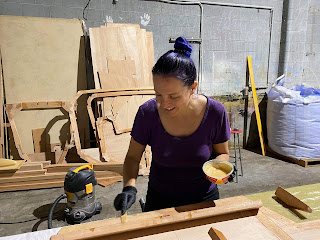After assembling frame E, I continued the frame assembly process from smaller to larger and more complicated frames. The next frame I assembled was frame D. It's still relatively small and simple, with all pieces fitting on my workbench. By the time I was assembling the second frame, I already had the basic skills and confidence to be able to do this well.
I started to get a good feel for how much epoxy was needed for each job, so I was able to mix small batches quickly and accurately and not waste excessive amounts. As per the advice of experienced boat builders, I always pre-wetted the surfaces with unthickened epoxy, then added microfibers to the epoxy to create a paste that cures into a very strong structural bond. When assembling bigger pieces, it's also important to measure diagonals to ensure the frame is square. Generally, 80% of the time goes into laying out and pre-drilling frame components to ensure all is laid out according to plans and matches dimensions. The epoxying step is the fun part, and if you do the prep work, it's like butterring up the slices!
After frames E and D, I moved on to assembling frames B & C. While these two frames don't have any solid ply components, they are getting on the large size and thus checking for squareness is very important.
Lastly, I built the frames P (stern), A (cockpit), S (companionway), and D1 (main watertight bulkhead with compression posts). Frames P, A and S are actually quite straightforward if you're building from a kit like I did because all the guidelines for where the timber pieces go are pencilled on the plywood panels.
Frame D1 took the longest in the end since I had to prepare the oak timber components for the keel beam, posts and mast beam. I laminated and notched these before assembling the frame.
Lastly, I decided to finish all frames for both aesthetics and practicality. I filleted all the inset corners, routered and sanded outer corners and filled hollow corners. All frames were coated with three coats of clear epoxy. These finishing touches are not essential and could save a lot of time if you skipped them, but in hindsight, I am very glad I was pedantic and did it.
The timeline for frame assembly and finishing was roughly from April to July 2021. I was still working full-time during most of this time, so I generally worked on the boat in the evenings. It probably took me, on average, 2-4 hours to build each frame, from laying out the pieces to epoxying. The finishing touches took another 6-8 hours per frame.



















No comments:
Post a Comment